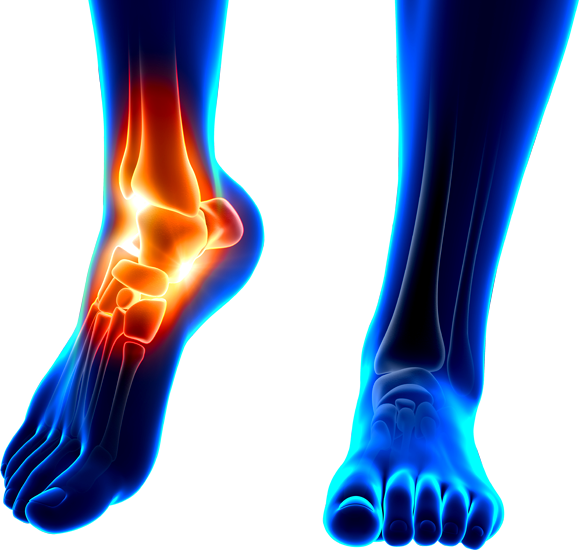Leeds Foot & Ankle Clinic
Experts in foot and ankle surgery

Plantar Fasciitis.
What is Plantar Fasciitis
Plantar fasciitis is a common condition that causes pain and inflammation in the heel and sole of the foot. It occurs when the plantar fascia, a thick band of tissue that supports the arch of the foot, becomes strained or irritated. In most people, this condition is part of a normal aging process resulting from degeneration within the plantar fascia. It can be caused or worsened by overuse such as doing lots of running or long days standing and walking, improper footwear, excessive weight, or certain foot conditions.
How can Plantar fasciitis be Treated
The good news is that plantar fasciitis can often be managed and treated effectively with simple non-surgical measures. The following treatments can help alleviate pain, reduce inflammation, and promote healing:
If you take the time to carry out the following treatments, especially the exercises, you should see some improvement in your symptoms in around 3-4 months. It does take time so stick with it!
-
1. Rest and Ice:
Resting the affected foot and applying ice packs to the painful area can help reduce inflammation and relieve pain. Apply ice packs wrapped in a tea towel for 15-20 minutes at a time, several times a day. You can also try rolling a frozen 500ml bottle of water under the arch of your foot.
-
2. Pain Medication:
Over-the-counter pain medications such as Ibuprofen and paracetamol, taken regularly will help to improve your pain. Take the dose given on the packet at the required interval. Some people are advised not to take anti-inflammatories like Ibuprofen, so if you are unsure, please check with your pharmacist.
-
3. Supportive Footwear:
Wear supportive shoes with good arch support and cushioning. Basically, an athletic style trainer shoe is usually the best thing to wear as these are designed for both comfort and good support. Avoid high heels, flat and flimsy shoes such as pumps / flip flops / sandals, do not use very worn-out footwear with no cushioning left in the sole, and avoid walking bare foot on hard floors at home. These can all worsen the condition.
-
4. Heel Drop Exercises
**These are the most important exercises you need to do to help you recover**
Heel drop exercises help stretch the plantar fascia and calf muscles. These are the most important exercise to perform and will help you to recover as quickly as possible. Here's how to perform them:
- a. Stand on a step (bottom of stairs or door step for example), with only the balls of your feet on the edge so that you’re your heels hanging off.
- b. Slowly lower your heels down toward the ground until you feel a gentle stretch in the calves and arches of your feet. It should feel uncomfortable in the plantar fascia if you are doing it correctly. This is normal.
- c. Hold the stretch with your heels as far down as you can and count to 10, then raise your heels back up to the starting position.
- d. Repeat the exercise 10-15 times, twice a day.
- e. Gradually increase the number of repetitions you do as you improve and can tolerate more. You can also try to do them with only a single heel by lifting one foot off the step and dropping the whole of your weight using just one foot. Be sure to balance yourself with a banister or rail if attempting this.
-
5. Plantar-Specific Stretching:
Stretching the plantar fascia can help reduce tension and promote flexibility. Follow these steps to perform plantar-specific stretches:
- a. Sit on a chair and cross the affected foot over to rest on the opposite knee.
- b. Using the same hand as the foot you are stretching, gently pull your toes back towards your shin until you feel a stretch along the bottom of your foot.
- c. Hold the stretch for 15-30 seconds and repeat 3-4 times.
- d. Perform this stretch multiple times a day, especially before taking your first steps in the morning.
-
6. Orthotics:
Usually, just wearing well supporting and cushioned footwear such as trainers is enough to support the plantar fascia. You can also try using a “silicone heel cup” to provide some additional shock absorbing and cushioning. These can be purchased on line.
-
7. Physiotherapy:
In some cases, especially when this condition is associated with calf muscle tightness or is causing other problems with walking or weakness, some physiotherapy may be beneficial.
-
7. Weight Management:
**This is really important**
Maintaining a healthy weight will reduce the strain on your feet and minimize the pressure on the plantar fascia. Weight loss if you are overweight is one of the most important measures you can take to help improve this condition.
-
When should I Seek Medical Attention?
First of all, it is important that you see someone who can make an accurate diagnosis of your condition before you begin treatment. This can be your own GP, a podiatrist or you can come to see a foot and ankle specialist at our clinic. There are other reasons why you may suffer from pain in and around the heels so it is vital to get the diagnosis correct.
This guide is intended for patients with a confirmed diagnosis of plantar fasciitis. Please do not use it if you have not been given this diagnosis by a profession. It is important not to self-diagnose as you may be wrong.